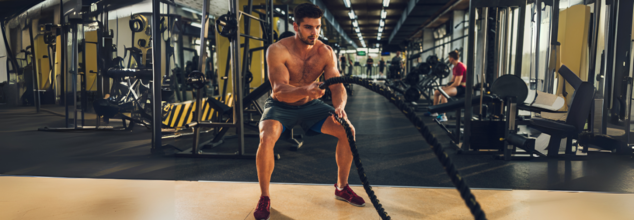- Health Conditions A-Z
- Health & Wellness
- Nutrition
- Fitness
- Health News
- Ayurveda
- Videos
- Medicine A-Z
- Parenting
- Web Stories
3-Day Dumbbells for Muscle Gain Home Work Out

3-Day Dumbbells for Muscle Gain Home Work Out
When you don't have enough equipment, a set of dumbbells is good enough to give a great workout for muscle building and fitness. This full-body work can get the job done, whether to be used for an easy home routine or to shock those muscles into a growing spurt.
Dumbbells are very versatile because with them you can do everything from heavy compound lifts to helping build muscle with minimal equipment. Such is this workout plan, suitable for men and women, actually designed so as to maximize both strength and muscle gains with just a pair of dumbbells, and you can follow this program for a pretty long time if you're seeing progress. And if you are in a rut or you want to try something different, this is a simple solution.
Weekly Workout Routine
This three-day dumbbell workout is done Monday, Wednesday, and Friday. No additional exercises are necessary; however, cardio can be added either in the morning or after you finish your resistance training for weight loss or to build endurance.
Monday - Full Body
- Dumbbell Squat – 3 sets of 6-12 reps
- Dumbbell Bench Press – 3 sets of 6-12 reps
- One Arm Dumbbell Row – 3 x 6-12 reps
- Standing Dumbbell Curl – 3 x 6-12 reps
- Two Arm Seated Dumbbell Extension – 3 x 6-12 reps
- Sit Ups – 3 x 10-25 reps
Wednesday - Full Body
- Dumbbell Step Up – 3 x 6-12 reps
- Dumbbell Stiff Leg Deadlift – 3 x 6-12 reps
- Seated Dumbbell Press – 3 x 6-12 reps
- Standing Dumbbell One Leg Calf Raise – 3 sets of 10-20 reps
- Dumbbell Shrug – 3 sets of 10-15 reps
- Dumbbell Side Bends – 3 sets of 10-15 reps
Friday - Full Body
- Dumbbell Lunge – 3 sets of 6-12 reps
- Dumbbell Floor Press – 3 sets of 6-12 reps
- Wide Grip Pull Up – 3 sets of 6-12 reps
- Standing Hammer Curl – 3 sets of 6-12 reps
- Dumbbell Extension Lie - 3 sets of 6-12 reps
- Floor Leg Raise Lie - 3 sets of 10-25 reps
Key Principles to Succeed
1. Progressive Overload: Gradually challenge yourself in completing more reps in a set with proper form. When you become accustomed to the higher end of the rep range 6-12, it is time to progress your loading on some weight.
2. Never Train to Failure: Train only up to the point when you feel you can fail on the next repetition but never push on to the point of actual failure. Continuous progressive training is achieved without the risk of injury.
3. Nutrition is Important: For muscle building, more calories than needed for maintenance should be taken in. Although strength can still be gained without excess calories, muscle mass buildup is hard to achieve without the help of excess calories.
Note for Women: For women, the appropriate rep range would be 10 to 15 on most sets. In general, there is no need to be apprehensive when lifting heavier weights-dumbbells are a safe and effective way to tone and strengthen.
Why It Works?
Compound Movements: Compound movements are exercises that recruit several joints and, thus, many muscle groups within one exercise. This routine is full of compound movements, designed to dominate your workout time by toning various muscle groups at once. This approach also maximizes the potential for overall strength and mass.
Simplicity and Flexibility: You don't need to have access to high tech gym equipment. The pair of dumbbells will do the trick along with commitment to the routine. For as long as you see constant strength and muscle gains, you can stick with this program for months.
Balanced Approach: Work all major muscle groups and build up your core, meaning not only is the program balanced, but you've got balanced development too.
With consistency, proper form, and an emphasis on progress, you can see your physique transform—from the comfort of your very own home!
Exercising At This Time Of The Day Not Only Helps Your Heart, But Also Strengthens Your Lungs

Exercising is a crucial part of keeping ourselves healthy. Whether it is walking, going to the gym or even working out at the weekends, it is very important for your body. Everybody has their own preferences regarding exercising, while some people find it much better to exercise early, others go for evening exercises.
Research published in the Medicine & Science in Sports & Exercise journal suggests that exercising in the morning could be especially good for the heart and lungs of older adults. The study also found that simply having a regular exercise routine can bring health benefits. Experts explained that getting physical activity earlier, consistently, and more often during the day might help you stay fit as you get older.
What the Study Revealed
To understand how the time we exercise affects our overall fitness and health, scientists looked at health information from 799 older adults (average age 76). Participants wore devices on their wrists for seven days to track their activity. They also underwent tests to check their heart and lung health and had regular doctor visits. Here's what researchers discovered:
- Being most active in the morning (what they called "peak morning activity") was linked to better heart and lung fitness and more efficient walking (meaning the body uses energy better while walking).
- Exercising at the same time each day consistently was connected to better health outcomes.
- People who had regular patterns of rest and activity throughout the day showed better heart and lung fitness and walking efficiency.
Why Exercise Timing Might Matter
There's still a lot to learn about how the timing of our physical activity affects our health and the risk of long-term diseases. More research is definitely needed to fully understand this link.
However, researchers suggested that the connection between exercise and our body's natural circadian clock (our 24-hour internal rhythm) might explain why timing matters. This internal clock controls things like body temperature and hormone release. So, the time of day you're most active could actually impact how well you perform and even how your muscles respond at a very basic level. Depending on the timing, working out could also either shift your internal clock or keep it steady, which seems to help muscle cell function and overall metabolic health.
Lastly, it's worth noting that everyone has a chronotype – whether you naturally feel more awake in the morning, afternoon, or evening. Scientists believe that knowing your chronotype and planning your activities accordingly could significantly impact your health and fitness.
Should You Exercise in the Morning?
The American Heart Association suggests getting 150 minutes of moderate exercise or 75 minutes of vigorous activity per week. But a growing amount of evidence suggests that even short bursts of movement – even just 20 minutes a week – can significantly benefit your heart.
One sports medicine doctor emphasized that any amount of exercise makes a difference and that whether you exercise is more important than when. Another expert agreed, highlighting that having a consistent exercise schedule is also very important. Both the new study and other research show that sticking to a routine offers many benefits, from preventing long-term diseases to improving survival rates with cancer.
Science Shows What Exercise You Should Do According To Your Personality

Many times, the things we like to do aren’t easy to do. While it may suit other people, there is no guarantee that it is the best for you. So how does one go about looking for the exercises that suit us? How about picking exercises according to your personality?
A recent study published in the Frontiers in Psychology journal suggests that picking your exercise according to the kind of personality you have could be the best idea. The study suggests that if your workout fits your personality, you're more likely to stick with it and see better results.
Researchers mentioned that our personality affects how we respond to and engage with exercise. Think of it from a different perspective, like a person who enjoys talking and having conversations with people, they fair better in jobs that allow more face-to-face interactions. Similarly, this study explains that some aspects of our personality could help us find better results with a certain type of exercise. Understanding ourselves and others can help create personalized fitness plans that lead to lasting changes in how active we are.
How Your Personality Shapes Your Workout Choices
Researchers wanted to make physical activity more enjoyable for people. So, they explored how personality affects what kind of exercise people prefer and how committed they are. They studied 86 individuals over eight weeks. First, participants filled out surveys about their stress levels and personality traits, like how friendly or anxious they tend to be. Then, they underwent fitness tests and were divided into two groups:
- A "resting" group that continued their usual daily activities and did some light stretching each week.
- Another group that performed cycling and strength training at home.
Throughout the study, participants regularly reported how much they enjoyed their exercise sessions.
Finding the Best Workout for Your Personality
The study didn't pinpoint exact exercises for specific personality types, but it did reveal some general patterns connecting what are called the "Big 5" personality traits with workout preferences:
- Extroverts often enjoy intense workouts with other people, like team sports.
- Anxious individuals tend to prefer private workouts with breaks built in.
- Conscientious people generally fit in more physical activity each week and show better overall fitness.
- Agreeable people like to exercise for a while but prefer activities that are less intense.
- Open-minded individuals are willing to try different workouts, but they might rate very strenuous or high-intensity exercises lower than other groups.
It makes a lot of sense that your personality strongly affects your workout preferences. Your traits influence your willingness to try new things, how you feel about effort, and your comfort in different environments, making exercise a natural way for these tendencies to show up.
Experts note that this study was stronger because it used objective measurements rather than just relying on what people reported about themselves, which is common in similar research.
However, the study wasn't perfect. More than 70% of participants were described as open-minded, conscientious, and emotionally stable, meaning the group might not fully represent everyone in the general population. Plus, the study didn't account for participants' past exercise experience or why they chose particular workouts.
Your Fitness Journey, Your Choices
Tailoring your fitness program to your personality could potentially boost your exercise gains and overall health. Finding workouts that people will actually do and stick with is crucial for consistent physical activity.
If you're thinking about trying a new workout, experts suggest reflecting on your own personality traits and the types of activities you usually gravitate toward. It's helpful to pay attention to how you feel after different types of sessions, whether it's a strength workout, yoga, or a run. Ask yourself if it energizes you, calms you down, or just makes you too tired for anything else.
However, it's also important to think about other factors that might help you stick with an exercise routine, such as how easy it is to access, any injuries you might have, and your specific fitness goals.
Being willing to adapt and create a plan that truly works for you will help you achieve more long-term benefits. Setting clear goals that include measurable progress is an excellent way to build towards success.
How Much Exercise Do You Need To Build Muscles - The Number Of Sets May Surprise You

(Credit-Canva)
For beginners, weight exercises may seem tedious and something that will take a long time to show results. Many people also find that sometimes even despite exercising regularly, slow progress can make them feel discouraged, leading them to grow tired of working out. However, research shows that you do not need countless hours of working out, there is a specific point and set of habits that lead to the best results.
A new study, a preprint posted in SportRxiv, reviewed 67 studies to pinpoint what exercise habits led to the best muscle and strength improvements. The findings indicate that while doing more sets in a weightlifting session helps with both muscle strength and growth, there's a point where it stops being as effective.
How Many Sets Are Best Per Workout?
One of the study's authors noted that while there's been much research on how often to train and how many sets to do, fewer studies looked at how to split your activity across different workouts. To find answers, the team analyzed many studies involving thousands of people. They looked at two types of sets:
- Direct sets which are exercises that primarily work a specific muscle.
- Indirect sets are exercises where a muscle is working, but it's not the main focus (counted as "half" a set).
Their analysis showed that muscle and strength generally increased with more sets per session. However, the data also showed a stopping point. Muscle growth leveled off after about 11 indirect sets in a single session. On the other hand Strength gains leveled off after around two direct sets in a single session. This means that the first few sets you do in a workout give you the biggest benefits. More sets do seem to help, but only up to a certain point.
Creating Your Ideal Strength Routine
The study's findings can help people make their workouts more efficient and plan their weight training. For strength, it makes sense to train more often—about two to three times a week—with relatively few sets each time. This approach also works for muscle growth. Alternatively, for muscle growth, you could go to the gym less often but do a few more sets in each session. Even if you're not super strict about your routine, know that regular, moderate strength exercise can have a big positive impact on your health.
Why Fewer Sets Can Lead to More Gains
It might seem strange that doing fewer sets could lead to more strength, but these findings match what earlier research has shown.
Fewer sets with heavier weights have long been known to increase strength by helping you improve your ability to produce force. The initial challenging sets help to use the most muscle fibers and kickstart most of the strength-building processes.
Basically, once you've done one or two hard sets, more sets after that add very little extra benefit. Instead, they add a lot more tiredness and make your recovery time longer. If you train too much over time, you'll feel more tired and won't perform as well, especially when it comes to pure strength.
Using Research to Plan Your Next Workout
Whether you're a fitness enthusiast or just starting, this research can guide you on how to get the most out of your weight training: try focusing on just a few sets, repeated about three times throughout the week.
For beginners, it's suggested to start with fewer sets and add more if you stop seeing results. When it comes to the ideal number of repetitions in each set, it depends on your fitness goals:
- Fewer reps (about 1 to 5) are good for strength and power.
- About 6 to 12 reps are best for building muscle.
- Between 13 and 20 reps are recommended for muscle endurance.
- Make sure to allow enough rest between workouts for the same muscle groups
- It also helps to track your workouts—like how many sets, reps, and what weight you lifted—and adjust based on how your body responds.
© 2024 Bennett, Coleman & Company Limited

